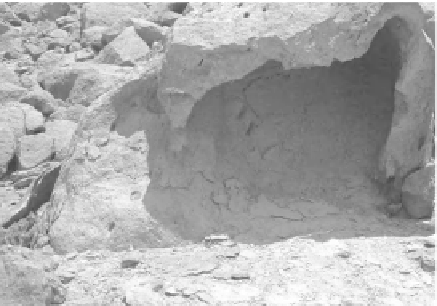Geoscience Reference
In-Depth Information
(a)
(b)
(c)
(d)
Lluta Valley
Punta Pateche
40
350
Chloride
Sulphate
Nitrate
Chloride
Sulphate
Nitrate
35
300
30
250
25
200
20
150
15
100
10
50
5
0
0
TA 4
TA9
TA10
TA11
TA12
TB2/1
TB3/1
TB5/2
TB6/1 TB11/1
Figure 6.6
Cavernous weathering in the Atacama Desert, Chile: (a) boulder with one large tafone and many alveoli, Lluta
Valley, Chile; (b) large flakes on the floor of tafone having been weathered from the upper surface; (c) crystalline salt deposits
from inside tafoni; (d) graphs showing concentrations of chloride, nitrate and sulfate from tafoni at Punta Pateche and Lluta
Valley measured in microgrammes per gram.
At both sites, especially in the Lluta Valley, tafoni development appeared to be highly active, as shown in Figure
6.6(b), with many newly detached large flakes on the floor of the tafoni. The remarkable feature at both sites was the
presence of hard, thick framboidal crystalline salt deposits within the tafoni, and especially within flaking material
at the sides and back of the tafoni. These deposits looked similar to many cave minerals found in subterranean
environments, and were clearly different to the powdery salt efflorescences often found in tafoni (see Figure 6.6(c)).
Basic geochemical analyses of these salt deposits are summarized in Figure 6.6(d). As can be seen, the site at Lluta
Valley contains very high levels of sulfate and higher levels of nitrate than Punta Pateche, with similar levels of
chloride at both sites.
These simple observations indicate that in these hyper-arid, but foggy, conditions salt weathering is highly likely
to be a key cause of the present-day development of these tafoni. Differences in the factors controlling tafoni
development are evidenced between the two sites. The field evidence also indicates that these tafoni are actively
and rapidly developing. Further monitoring studies need to be carried out to provide a better understanding of how
these tafoni are developing today and the key weathering processes involved, in comparison with those from other
arid environments. However, concepts such as self-organisation need to be invoked in order to explain the bigger
questions of the genesis and development of the entire system of cavernous weathering features in these areas.














